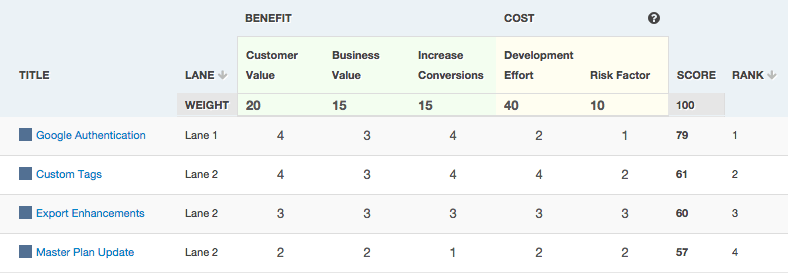We’re often asked whether we use our own product to plan and build ProductPlan. The answer is a resolute Yes – we’re using our product roadmap software to prioritize, well…our own internal product roadmap.
In other words, we’re eating our own dog food.
In this article, we’ll describe how Productplan prioritizes features on our product roadmap using our Planning Board.
Our decision-making process tends to be a bit more fluid, and not bureaucratic in the least. What features need to be built? What features give our customers the most value? Which features yield the biggest benefit for the lowest development cost? Which initiatives are the best use of our resources?
Although the specific prioritization questions may vary between companies, the decision process is often similar, whether you are a product manager working for a startup or a Fortune 500 company.
How ProductPlan Prioritizes their Product Roadmap
That’s where our Planning Board prioritization feature comes in. Here is the process we are using to make decisions:
- We use our Table Layout to capture big features, themes, and major initiatives. At any given time this list contains 20-30 big items. We will often group similar items together into a bigger theme, such as “PDF export improvements.” Smaller features, usability testing issues, and bugs get added to our agile project management tool (Pivotal Tracker).
- Using our Table Layout, a small group does gut-level ordering based on our feel for customer impact and our internal strategic goals.
- Then using our Planning Board prioritization feature we pull in the top handful of items from the Table Layout for scoring. If we are considering shifting something on our product roadmap, we’ll pull in one or more roadmap items to give us a side-by-side comparison.
- We have a discussion to score items based on their Benefit versus Cost categories. See our categories below. The Planning Board makes this easy.
- Of course, the score isn’t the only factor for making the decision. The team also introduces other factors into the discussion such as the timing of other features, urgency, competitors, results from customer satisfaction surveys, the mix of engineering skills on the team, and so on.
- We then drag and drop the top items onto our roadmap.
- We continually revisit the roadmap based on our shifting priorities and new opportunities that arise. We’ll often compare new initiatives with items already on our roadmap.
Our Prioritization Criteria: Benefit versus Cost
The Planning Board is customizable, so you can determine the decision categories that are appropriate for your organization. At this point in time, our decisions boil down to the following categories:
- Customer value – the impact and value that a feature gives to customers. How much better can they perform a job with this new feature? How much pain are we reducing? This is our number one consideration.
- Strategic value – how much does the initiative or feature align with our internal strategic goals? Some might call this business value.
- Increase conversions – because we’re a fast-growing SaaS company, we pay particular attention to features that convert users to customers or help customers expand their use of ProductPlan.
- Development effort – a rough gauge of effort required from our engineering and QA team to release the feature. This is a simple “easy versus hard” discussion.
- Risk factor – risk that a feature will be more difficult than expected or have other complications.
Here’s how this looks in our Planning Board:

One of the powerful things about our Planning Board is that our team can adjust the weighting on the fly. So if we are implementing programs and features that impact customer acquisition, we can give that a higher weighting for a particular round of discussions.
This is our prioritization approach at this point in time, and it’s continually changing based on understanding our customers, our changing priorities, and new opportunities that arise. Our approach will likely be different in 12 months, and the Planning Board will adjust along with us.
Want to give the Planning Board a try for your own product roadmap? Try it free for 14 days.



